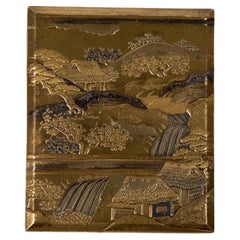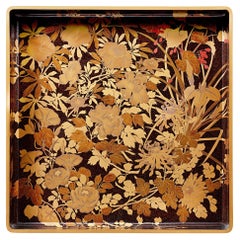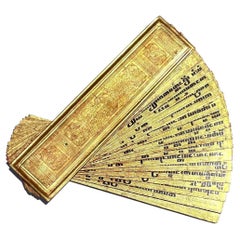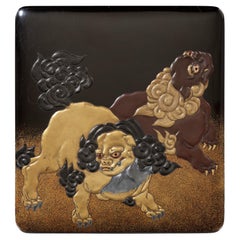Gold Lacquer
45
to
4
28
16
45
45
45
1
1
12
26
7
2
1
3
1
1
1
3
476
287
116
45
32
44
34
32
7
5
Material: Gold
Japan lake landscape kobako box lacquer - Edo
Located in PARIS, FR
Rectangular kobako box in takamaki-e and kirigane gold lacquer circled with pewter depicting a lake landscape. Inside and back of the box in nashi-ji lacquer.
Japan – Edo period (16...
Category
18th Century Japanese Antique Gold Lacquer
Materials
Gold
Japanese Lacquer and Gold Tray
Located in New Orleans, LA
This Meiji-period lacquer tray represents the mastery of Japanese craftsmen in the art of lacquer work. Precious materials are precisely inlaid in the lacquer base, creating a highly...
Category
Late 19th Century Asian Meiji Antique Gold Lacquer
Materials
Gold
Antique Burmese Gilt Lacquered Kammavaca Manuscript
Located in Point Richmond, CA
Antique Burmese Gilt Lacquered Kammavaca Manuscript, Consisting of 2 lacquered wood end covers and 16 double sided folios of lacquered cloth in red and black with gold leaf. This Kam...
Category
19th Century Burmese Other Antique Gold Lacquer
Materials
Gold Leaf
Japanese lacquer suzuri’bako 硯箱 (writing box) with shishi & Hotei design
Located in Amsterdam, NL
A captivating lacquer suzuri’bako (writing box) of rounded rectangular form depicting a pair of shishi (temple lions) and the lucky god Hotei 布袋 on a rôiro...
Category
Early 19th Century Japanese Antique Gold Lacquer
Materials
Gold Leaf, Silver Leaf
Japanese golden kobako flowers Edo period 18th century
Located in PARIS, FR
Quadrangular kobako box decorated with flowers in gold and blue lacquer with aogai inlay. Lid and sides in fundame lacquer, underside and interio...
Category
18th Century Japanese Japonisme Antique Gold Lacquer
Materials
Gold
Japanese landscape pine kobako box Edo period 18th century
Located in PARIS, FR
Rectangular black and gold lacquer kobako box decorated with pine trees in a mountain landscape in takamaki-e, kirigane and hiramaki-e lacquer. Background in nashi-ji lacquer. Surmou...
Category
18th Century Japanese Antique Gold Lacquer
Materials
Gold
Japanese Lacquer Box
Located in New Orleans, LA
This exquisite Meiji-period lacquer document box known as a ryoshibako showcases the meticulous artistry of maki-e, a technique of raised lacquer decoration. Adorned with gold and vi...
Category
19th Century Asian Meiji Antique Gold Lacquer
Materials
Gold
A Japanese export lacquer box with depiction of the Grand Hotel, Yokohama
Located in Amsterdam, NL
Meiji period, circa 1873-1887
The black lacquered box decorated in maki-e and hiramaki-e gold, with on the lid a European style building complex and several Japanese and European figures walking along a street in the foreground. The sides are finely decorated with several insects and the inside with several compartments and nashiji decoration.
H. 7.4 x W. 29 x D. 25.7 cm
After the Americans forced Japan to open their harbours to the outside world and take part in international treaty and trade around the mid 19th century, the formerly feudal society rapidly changed. Japan was now focussing on an industrial future. One of the major international ports was Yokohama with its foreign embassies and warehouses - which attracted a great number of visitors of all sorts. For the higher society visiting Japan for the first time a new and ‘Western’ hotel had to be realised; hence the construction of The Grand Hotel on Kaigandori.
The hotel was opened on August 16, 1873 (Meiji 6) and was soon considered the height of Western culture and elegance in Japan. The building probably depicted on this box, designed by American architect Richard P. Bridgens (リチャード・ブリジェンス, 1819 -1891), is the original hotel...
Category
19th Century Japanese Antique Gold Lacquer
Materials
Gold
Edo Maki-e Japanese Box
Located in Brescia, IT
Japanese box with lacquer lid finely decorated with Maki-e, dating from the 18th century, mid-Edo period.
The box is of special size to preserve important calligraphy.
All sides of ...
Category
Late 18th Century Japanese Edo Antique Gold Lacquer
Materials
Gold Leaf
Japanese suzuribako lacquered box peony river
Located in PARIS, FR
Suzuribako box (empty) in black lacquer. Gold maki-e decoration of a river bordered by peonies, one with red highlights. The edges of the lid are in gold lacquer. Nashi-ji interior.
Category
Late 19th Century Japanese Antique Gold Lacquer
Materials
Gold
Japanese peony basket lacquered box Edo
Located in PARIS, FR
Eight-sided, flared shaped lacquer kobako box, following the decoration on the lid depicting a basket of flowers, composed of peonies and chrysanthemums in gold takamaki-e and hirama...
Category
18th Century Japanese Edo Antique Gold Lacquer
Materials
Gold
Japanese Lacquer Stationery Box, Suzuribako, Edo Period, 19th c, Japan
Located in Austin, TX
A fine and elegant Japanese lacquer box for writing implements or stationery, suzuribako, with an image of a Shinto shrine, Edo Period, mid-19th century, circa 1840, Japan.
The exqu...
Category
Mid-19th Century Japanese Edo Antique Gold Lacquer
Materials
Gold Leaf
Japanese Lacquer Tray With Cards
Located in New Orleans, LA
This Meiji-period lacquer tray represents the mastery of Japanese craftsmen in the art of lacquer work. Precious materials are precisely inlaid in the lacquer base, creating a highly...
Category
Late 19th Century Japanese Meiji Antique Gold Lacquer
Materials
Gold
Antique Chinese Red and Black Lacquer Wedding Basket With Gold Leaf
Located in Sheridan, CO
Antique Chinese Wooden Wedding Basket (c. 1860 - 1880) with red and black lacquer finish. So-called Peking opera basket. Top in gold leaf design depicts a Chinese sage on horseback w...
Category
Mid-19th Century Chinese Antique Gold Lacquer
Materials
Gold Leaf
Guangxu Chinese black gold Jewelry Box, yellow silk
Located in Valladolid, ES
Exquisite Chinese Jewelry Box, made for export, France. With a stamp inside of Joan of Arc, Domremy. End S XIX-PP S XX
Silk lined interior. Polylobed profile, the entire body covere...
Category
1880s Chinese Chinese Export Antique Gold Lacquer
Materials
Gold Leaf
Vietnamese Lacquer By Pham Chinh Trung
Located in Jersey City, NJ
Image without original frame 13.5 by 19.5 inches Pham Chinh Trung is a Vietnamese lacquer born in 1955 in Vietnam. ...
Category
1990s Vietnamese Gold Lacquer
Materials
Gold Leaf
Important Signed Vietnamese Lacquer
Located in Jersey City, NJ
This lacquer is decorated with deers in a lush environnement in lavish reds with a waterfall in silver leaf. It has a seal and is signed by the artist. Lacquer is an ancestral Viet...
Category
1950s Vietnamese Vintage Gold Lacquer
Materials
Gold Leaf
Vietnamese Lacquer By Pham Chinh Trung
Located in Jersey City, NJ
This a Lacquer on wood signed and dated in the lower left corner. Pham Chinh Trung was born in 1955 in Vietnam. He graduated from Hanoi university of industrial fine arts in 1979. Sp...
Category
20th Century Vietnamese Gold Lacquer
Materials
Gold Leaf
Vietnamese Lacquer Pham Chinh Trung
Located in Jersey City, NJ
With frame Width 23, Height 16 inches This lacquer bt Pham Chun Trung is signed and dated 92 in the lower left corner. The artist was born in 1955 and was graduated in 1979 from Hanoi University of Industrial Fine Arts. He specialized in the technique of lacquer on wood and began to exhibit his works in the early nineties of the twentieth century. Lacquer is an ancestral traditional Vietnamese art...
Category
1990s Vietnamese Gold Lacquer
Materials
Gold Leaf
Vietnamese Lacquer By Pham Chinh Trung
Located in Jersey City, NJ
Pham Chinh Trung is a Vietnamese artist born in 1955. This lacquer is signed and dated 93 in the lower left. Pham Chinh Trung graduated from Hanoi University of Industrial Fine Arts...
Category
1990s Vietnamese Gold Lacquer
Materials
Gold Leaf
Japan 1810 Kajikawa Edo Period Five Drawer Inro Lacquered Gilt Wood With Rooster
Located in Miami, FL
Japanese Inro from the Edo period (1615-1868) created by Kajikawa.
Beautiful Inro, created in Japan by one of the Kajikawa family during the Edo period (1615-1868), circa 1810. Has been carefully crafted in carved precious wood with applications of gilding maki-e and decorated with Japonism patterns. All dan trays are attached together with a himo cord. The detailed craftsmanship was a true pleasure to behold.
Period: Edo period (1615-1868). Shogunate.
Approximate Date: 1790-1810
Motif: A family of birds consisting of a cockerel, the hen and three chicks.
Drawers: Five.
Shape: Rectangular navette.
Technique: Carved wood, lacquer and decorated in iroe-hiramaki-e on a gold ground.
Ojime: 15mm 20mm, oval carved from natural translucent agate.
Netsuke: None
Weight: 47.70 Grams.
Measurements: Inro is 78 mm by 55 mm by 18 mm (3.07 x 2.17 x 0.71 Inches).
Signatures: Kajikawa Saku, in the underside with the signature KAJIKAWA. By a member of the Kajikawa family, signed Kajikawa 梶川 Japan, late 18th century to early 19th century, Edo period (1615-1868).
The Kajikawa family
Kajikawa family, flourished in the 19th century, they was Japanese lacquerware artists whose school in Edo (now Tokyo) flourished for more than 200 years. This family is perhaps the most famous of all the dynasties of Japanese lacquer artists, and certainly the name most often found on inro. The family is said to have been founded by Hikobei at Edo in the early 17th century, although some claim that the family’s great reputation really stemmed from his son and pupil Kyujiro. In any event, Hikobei worked for the shogunate, as did his successors until well into the 19th century. Kijirō excelled in designing particularly delicate lacquer inrō, portable medicine cases...
Category
1810s Japanese Edo Antique Gold Lacquer
Materials
Agate, Gold
17th Century Japanese Export Lacquer Cabinet with Depiction the Dutch Tradepost
Located in Amsterdam, NL
A highly important Japanese export lacquer cabinet with depiction of the Dutch East India Company tradepost Deshima and the annual Dutch delegation on its way to the Shogun in Edo
Edo period, circa 1660-1680
H. 88 x W. 100.5 x D. 54 cm
This cabinet includes a later European japanned stand, but also a modern powder-coated steel frame.
The latter can be designed and added to your specific needs.
The sides and front of the rectangular two-door cabinet are embellished in gold and silver hiramaki-e and takamaki-e on a black roiro lacquer ground with a continuous design. The two doors depict a long procession of numerous figures travelling on foot and horseback along buildings and a pagoda into a mountainous landscape. This is the annual court journey, Hofreis, of the Dutch from Nagasaki to the Shogun’s court in Edo. Three horseback riders are dressed as Dutch merchants and a fourth figure, probably het Opperhoofd, is seen inside a palanquin, norimon. Just about to cross the bridge, two men are carrying a cabinet like the present one.
Many Japanese figures on either side of the procession are engaged in various activities; some play musical instruments on board of small boats, others are fishing; figures inside buildings are depicted playing go, and farmers are tending to their rice paddocks. The upper part of the right door shows a large mansion, probably the local daimyo’s castle, with men kneeling before a man in the central courtyard.
The court journey fits in with the foreign policy of the shogunate which accorded a role to the VOC alongside China, Korea, and the Ryukyu Islands who also had to pay tribute. However, the VOC employees were traders, having low status in Japan’s social hierarchy, and they were received with less deference than were the state embassies from Korea and the Ryukyu Islands. Nevertheless, the contacts with the Dutch were a welcome source of information to the Shogun about Europe and European science and technology.
The left side of the cabinet depicts, in mirror image, a rare view of the artificial fan-shaped Deshima Island, the trading post for the Dutch in Japan. The island, where the Dutch flag flies, is surrounded by small Japanese boats and an anchored three-masted fluyt (cargo ship), flying Dutch flags, with on the stern the VOC monogram. On the bottom right a busy street of Nagasaki is shown, bordered by shops and leading up to the stone bridge. On the island the trees are beautifully painted, two cows can be seen, and the flagpole, all in very fine detail. Dutchmen and enslaved Malay are visible outside the buildings and two Japanese figures, probably guards, sit in a small hut in the centre.
A maximum of fifteen to twenty Dutchmen lived on the island at any time and soldiers or women were not allowed. Restrictions on Deshima were tight, and the merchants were only allowed to leave the island by special permission. The Opperhoofd had to be replaced every year, and each new Opperhoofd had to make a court journey to pay tribute, present gifts, and to obtain permission to Margaret Barclay eep on trading. In the distance, many birds fly above the hills and a four-story pagoda can be seen. The right side of the cabinet is painted with other horse riders and their retinue journeying through mountains.
The pair of doors to the front open to reveal ten rectangular drawers. The drawers are decorated with scenes of birds in flight and landscapes with trees and plants. The reverse of the left door with two thatched buildings, one with a ladder, underneath a camelia tree with large blooms; the right door with a three-story pagoda nestled among trees and both doors with a flying phoenix, ho-oo bird. The cabinet, with elaborately engraved gilt copper mounts, hinges, lock plates and brass handles, is raised on an 18th-century English japanned wood stand.
A pair of large cabinets...
Category
17th Century Japanese Edo Antique Gold Lacquer
Materials
Copper, Gold
Rare 17th Century Japanese Export Lacquer Medical Instrument Box
Located in Amsterdam, NL
A rare Japanese export lacquer medical instrument box
Edo-period, 1650-1700
L. 19 x W. 6 x H. 8.5 cm
This unconventionally shaped lacquer b...
Category
17th Century Japanese Edo Antique Gold Lacquer
Materials
Gold
Asian Black Lacquerware and Gold Tazzas, A Pair
Located in Garnerville, NY
A simply gorgeous pair of Asian black lacquer and gold leaf floral decorated tazzas. A tazza can be just for decorative value, while a compote is used to hold something such as food....
Category
Late 19th Century Japanese Meiji Antique Gold Lacquer
Materials
Gold Leaf
Japanese Lacquer Writing Box, Suzuribako, Edo Period, 18th Century, Japan
Located in Austin, TX
An exceptionally fine and unusual Japanese lacquer writing implements box, suzuribako, in the form of a zither, koto, Edo Period, 18th century, Japan. With a modern wood storage box,...
Category
18th Century Japanese Edo Antique Gold Lacquer
Materials
Gold, Silver, Copper
Japanese 19th Century Miniature Lacquer Chest with Waterfall
Located in Hudson, NY
Japanese 19th century miniature lacquer chest with waterfall. Late Edo to early Meiji period lacquer chest (mid to late 19th century) with two characters on the front reading Nuno an...
Category
Late 19th Century Japanese Antique Gold Lacquer
Materials
Gold, Silver, Bronze
Japanese black and gold foliage kobako
Located in PARIS, FR
Kobako box decorated with stylized foliage in black and gold hiramaki-e lacquer. The motif is karakusa, a growing plant extending in all directions. It symbols prosperity and longevi...
Category
Late 19th Century Japanese Antique Gold Lacquer
Materials
Pewter, Gold
Japan 1900 Meiji Miniature Hanagamidai Cabinet in Gilded Wood & Sterling Silver
Located in Miami, FL
Miniature hanagamidai cabinet from the Japan meiji (1858-1912) period.
Gorgeous and rare miniature drawers hanagamidai (cosmetic cabinet), created in the imperial Japan during the...
Category
Early 1900s Japanese Meiji Antique Gold Lacquer
Materials
Gold, Silver, Sterling Silver
Japanese Export Nagasaki Lacquer Box with the Portrait of Napoleon Bonaparte
Located in Amsterdam, NL
A Japanese export Nagasaki lacquer tobacco box with the portrait of Napoleon Bonaparte
Edo-period, circa 1810
The box in black lacquer on copper, ...
Category
19th Century Japanese Edo Antique Gold Lacquer
Materials
Copper, Gold
Four magnificent 17th-century Japanese export gold lacquer Liquor or Gin bottles
Located in Amsterdam, NL
A set of four extremely rare and important pictorial-style Japanese export lacquer bottles
Edo-period, circa 1650-1680
H. 15.5 x W. 6.9 x B. 7.6 cm (each)
The bottles with red cop...
Category
Mid-17th Century Japanese Edo Antique Gold Lacquer
Materials
Copper, Gold, Silver
Japanese Lacquer Incense Box, Kogo, Momoyama or Edo Period, 16th/17th Century
Located in Austin, TX
A wonderful Japanese lacquer incense box, kogo, with a design of sparrows in flight, late Momoyama or early Edo Period, circa 1600, Japan.
The small box, called a kogo, was used t...
Category
Early 17th Century Japanese Edo Antique Gold Lacquer
Materials
Gold, Pewter
Orientalist Hand Painted & Gilt Black Lacquer Plate or Dish, 19th Century
Located in Chatham, ON
Orientalist hand painted and gilt decorated black lacquer papier-mâché plate on stand - possibly by Adt Frères - exceptional detail - unsigned - late 19th century.
Excellent/extra...
Category
Late 19th Century Asian Chinoiserie Antique Gold Lacquer
Materials
Gold Leaf
Pair of Large Japanese Carved Wood Temple Candleholders Edo Period
Located in Atlanta, GA
A tall pair of Japanese carved wood candle holders circa early 19th century (late Edo Period). The pair is carved in the typical form with a block base in the shape of stylized chrysanthemums and long fluted stem with changes in diameter that supports a grooved holder fitted with metal pricket. These types of oversized candle holders were traditionally used in Buddhist temples or Samurai's resident where they were placed on the altar table for worshiping. What is extraordinary of these candle stickers is that they feature a wonderfully conserved surface with lacquered gold leaf. The sparkling gold on the well weathered surface is visually striking. The professional conservation was performed in 2007 and as a result, the pieces display a wonderful aged Wabi-Sabi patina.
The piece retains an original invoice from Far Eastern Antiques...
Category
Early 19th Century Japanese Japonisme Antique Gold Lacquer
Materials
Gold Leaf
Fine Japanese Export Red Lacquer Box with Masonic Symbols, circa 1800
Located in Amsterdam, NL
A fine Japanese export red lacquer box with Masonic symbols
Kyoto/Nagasaki, 1800-1820
Red lacquer decorated with scattered flowers and flying birds with long tails in gold, wit...
Category
Early 19th Century Japanese Edo Antique Gold Lacquer
Materials
Gold
Fine 17th Century Japanese Export Black and Gold Lacquered Pictorial-Style Dish
Located in Amsterdam, NL
A fine Japanese export black and gold lacquered pictorial-style dish Nagasaki or Kyoto, 1680-1720
The dish with wide flat rim of Keaki wood (Zelkova species) in black lacquer with...
Category
17th Century Japanese Edo Antique Gold Lacquer
Materials
Gold
Japanese Nashiji Lacquer Tray with Crane and Wave Design
Located in Hudson, NY
Japanese Nashiji lacquer tray with crane and wave design, this exquisite tray is a masterful example of multiple lacquer techniques using gold (including maki-e and takamaki-e). This...
Category
Late 19th Century Japanese Meiji Antique Gold Lacquer
Materials
Gold
Japanese Red and Black Lacquer Maki-e Decorated Presentation Tray, dated 1917
Located in Austin, TX
A fine Japanese red and black maki-e lacquer presentation tray with original tomobako storage box, Taisho period, dated 1917, Japan.
The large prese...
Category
1910s Japanese Taisho Vintage Gold Lacquer
Materials
Gold
Japanese Lacquer Letter Box
Located in Hudson, NY
Gold and shell marsh irises with pewter walkway wrapping around box. Korin style subject matter, nashiji ground interior and bottom with artist signature inside the lid. Signature re...
Category
Late 19th Century Japanese Antique Gold Lacquer
Materials
Gold, Pewter
Japanese Lacquer Kogo 'Incense Box'
Located in Hudson, NY
Late Edo (1614 - 1868) period incense storage box in stacked, double fan design. Fans have bamboo and plum design with a chrysanthemum crest. Silver metal rim and seat, nashiji (gold...
Category
Mid-19th Century Japanese Edo Antique Gold Lacquer
Materials
Gold
Antique Japanese Lacquer Stacking Food Box 'Jubako'
Located in Hudson, NY
With all-over mother of pearl inlay and mon design of chrysanthemum in gold and black lacquer on top. The chrysanthemum is a national symbol of Japan and the Imperial family.
Category
19th Century Japanese Antique Gold Lacquer
Materials
Gold
Japanese Edo Period Igarashi School Long Lacquer Box, Tanzaku-Bako
Located in Austin, TX
A stunning Japanese Edo period lacquer tanzakubako, box for poem cards, late 18th-early 19th century, Edo Period, Japan.
Attributed to the Igarashi School, this box is masterfully ...
Category
Early 19th Century Japanese Edo Antique Gold Lacquer
Materials
24k Gold
Burmese Kammavaca Giltwood Box, Stand, and Manuscript, 18th/19th Century
Located in Austin, TX
A gorgeous Burmese carved and gold leafed teakwood stand and cover for a kammavaca manuscript, late 18th or early 19th century, Burma.
The manuscript chest is heavily rococo influenced, speaking to the French presence in the region at the time. The carved teak stand is formed as a raised platform set upon four large scrolling acanthus leaf feet, with carved flour-de-lis to the apron.
The cover for the stand is also carved from teak, and features a series of rectangular cartouches, each set with a red foil backed glass "gem", surrounded by shell inlay, and embellished with green and silver foil backed glass sequins.
The top of the cover features the same design motif, with the addition of thayo lacquer design elements, and is strongly reminiscent of Tibetan manuscript...
Category
Early 19th Century Burmese Rococo Antique Gold Lacquer
Materials
Gold Leaf, Foil, Silver Leaf
Pair of English Georgian Chinoiserie Red Lacquered Wall Mirrors
Located in New York, NY
Pair of English Georgian (mid-18th Century) red lacquered and Chinoiserie decorated wall mirrors with gilt carved open pediment top with a centered cartouche. (Priced as Pair).
Category
18th Century and Earlier English Georgian Antique Gold Lacquer
Materials
Gold Leaf
Japanese Black Lacquer Tana (Tiered Tea Cabinet) with Gold Family Crests
Located in Hudson, NY
Japanese Black Lacquer Tana (Tiered Tea Cabinet) with Gold Family Crests, Covered with gold family crest designs. Made of lacquered wood and bronze mounts. Interior has wonderful r...
Category
Early 19th Century Japanese Edo Antique Gold Lacquer
Materials
Bronze, Gold Leaf
Meiji Period Japanese Lacquered Gold Two-Part Box
Located in Hudson, NY
This very beautifully lacquered box is from the Meiji period in Japan. Made between 1864 and the end of the 19th century this small two tied box would have bee...
Category
19th Century Japanese Other Antique Gold Lacquer
Materials
Copper, Gold
Recently Viewed
View AllMore Ways To Browse
Japanese Gold Lacquer Box
Asian Wood Trays
Japanese Wood Inlay
Antique Asian Mother Of Pearl Furniture
Japanese Mother Of Pearl
Japanese Red And Gold Lacquer
Japanese Lacquered Plates
Antique Cinnabar
Maki E
Japanese Lacquered Tray
Antique Lacquerware
Gold Lacquer Tray
Chinese Cinnabar Furniture
Cinnabar Lacquer Furniture
Cinnabar Lacquer
Red Lacquer Boxes Asian
Antique Cinnabar Furniture
Asian Lacquerware





